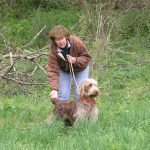POINTING DOG POINTERS: Gentle E-Collar Training
by Bob and Jody Iler
Can the electronic collar really be part of a positive and gentle training program?
The e-collar, as it’s commonly known, has been around for a long time. Years back, the collar was pretty primitive and usually had just one setting – high! More than a few good bird dogs were likely ruined by improper use of those old e-collars.
In the hands of a knowledgeable person, the e-collar of today has become a popular and useful tool for training, often known as the “invisible checkcord.” Its versatility includes use in handling, ground pattern and range issues, yard work, steadying to wing and shot, the trained retrieve, behavior issues, and more. When used properly, it can even be a lifesaver for a dog.
But does that mean you should use an e-collar on your dog?
If you were to check back over all the columns and articles we’ve written in the past 20-plus years for The Pointing Dog Journal, you won’t find many written primarily on just the e-collar. We’ve included specifics for its use in our more advanced training articles, such as steadying a dog to wing and shot, or teaching the trained retrieve.
However, we’ve never wanted to be known as “e-collar trainers.” We feel that if you don’t need to use an e-collar, all the better. Even with the refined collars of today that feature multiple levels of stimulation plus other bells and whistles, a person can still get into trouble and cause problems for his pointing dog that may be difficult to resolve. We say this because we’ve had dogs come into our kennel with these issues, and it can take a great deal of time to undo the damage.
So – first off – we don’t recommend using an e-collar on a puppy. You can still train pup and maintain reasonable control with a lead, checkcord, and proper yard, house, or kennel management techniques. But your big goal in pup’s first year is to get him bird crazy – hunting and pointing with enthusiasm and intensity. He’ll need to experience different hunting habitats, scenarios, and birds. You’ll school him in the basics of heel, whoa and here (come) and teach him to handle reasonably well in the field. All this can be done with lead, checkcord, and whistle.
Once his first season is over, it’s time to evaluate and see what issues have popped up that need to be addressed before they become bigger concerns and harder to fix. Maybe your young dog has become so enthusiastic in the field that he no longer comes to you when called. Or maybe as he ranges out hunting, he is ignoring your cues to change direction. This is where moderate use of the e-collar may be helpful.
But remember – never use the e-collar until after your checkcord and lead work has been completed during pup’s first year. The collar is only used to reinforce what you have already taught your dog. The e-collar is not an “easy fix” to be used for any issue that comes along, especially without laying the proper groundwork and training first.
Starting Out with the E-Collar
The manual that comes with the e-collar should be read completely. Most have excellent directions for use that should be carefully followed. When starting out, you’ll want to use the lowest stimulation setting on the collar. Test it on your wrist or arm so you know what the dog will feel – this makes you careful and respectful of the level of stimulation that you use.
Work in a yard or area with few distractions. Fit the collar snugly on the dog, and also attach his lead so you can heel him around the area. As you walk, push the lowest stimulation setting on the transmitter and watch your dog closely. You are looking for just a slight twitch of his ears or his eyes, maybe a slight drop of the tail. You definitely do not want a yelp of pain or the dog to jump as though he’s been struck! You may get no reaction at all with the lowest setting – if so, advance only to the next level – just until you get the mild reaction you are looking for. This exercise is simply to test for the right level of stimulation that you’ll use.
Adding Reinforcement to the Recall
Now that you feel comfortable with the level of stimulation you’ll use for your dog, replace the lead with his checkcord and go back into the yard or large area. Let him range out and get farther away from you as you walk around. When he’s not paying attention to you, give him the, “Here,” command and at the very same time, pop the checkcord and press the transmitter button. Your checkcord should be no longer than 15-20 feet so that you have no slack and can pop the checkcord quickly on his neck as you command, “Here,” and press the transmitter button – all done simultaneously.
Review this sequence well in your mind before you begin. Don’t overdo the session. Once you’ve called your dog to come a few times, he’ll get wise to what you want and won’t range out. Keep the sessions short and positive. Once he’s doing well with this training in the yard, go to a field and repeat the sessions there for a few days or a week or so. Don’t use any birds!
As you repeat these training sessions, begin to eliminate the pop of the checkcord – just give the “Here” command as you press the transmitter button. If the dog does well with the collar stimulus only, advance to letting him drag the checkcord around the field and use just the e-collar to reinforce your command. Eventually you can eliminate the checkcord. Many smart dogs become collar-wise. They know that when the collar is on, they get the stimulation along with the command. This is not necessarily a bad thing, except in field competitions where e-collars are not allowed. But just because your dog is wearing the collar does not mean you have to use it constantly. It’s there if you need it and should be used sparingly, if at all, once the dog responds well.
Putting Polish on Handling in the Field
Enthusiastic dogs will naturally range out farther and farther in the field and it’s important to remember that a pointing dog is bred to get out there and cover lots of ground for you. We don’t necessarily want him quartering in a rigid pattern, as he will hunt birdy objectives and use his nose to guide him and we’ll trust him on that. But there are times when your dog is ranging out too far for comfort and there are times when you need to change direction and want him to follow suit. After all, you are hunting partners, working together.
If you’ve laid the groundwork in the recall exercise above, it’s a simple matter to extend this to handling in the field. For a while, you’re going to go back to practicing your basic quartering and zig zag patterns in the field with your dog, using the 15-20 foot checkcord. You’ll start out in a forward pattern, and then turn to the right at the same time as you pop the checkcord on your dog’s neck, press the transmitter button, and use your voice or hand signal to direct your dog. This will take a bit of coordination and practice on your part: turn to the right; “bump” the dog with your transmitter as you pop the checkcord; and whistle, call, or hand signal the dog – all at the same moment. Continue walking in the new direction for a while and then make an abrupt turn to the left and repeat the same process. Make sure the turn, the pop, the bump, and the signal are all done in the same movement.
You’ll repeat these practice sessions until your dog is responding well to the stimulus of just the collar as you turn and direct him by voice, whistle, or hand signal. Again, you can let him drag the checkcord until you’re sure he’s ready, and then you can remove it. Over time, you’ll be able to run your dog without the checkcord and still have the control you want.
When working with the e-collar, everything should be positive and light-handed. It’s important not to rush the exercises. In most conditions you’ll want to use the lowest setting that your dog responds to, but in future field sessions with flyaway birds that your dog is chasing to the horizon, you may need to up the stimulation level a bit. Take your time, back up when necessary, and be patient and gentle with this training!
Remember, the less you have to use the e-collar, the better!
Pointing Dog Pointers features monthly training tips by Bob and Jody Iler, who own Green Valley Kennels in Dubuque, Iowa. Bob and Jody have trained pointing dogs for over 35 years and have written many articles for The Pointing Dog Journal.








